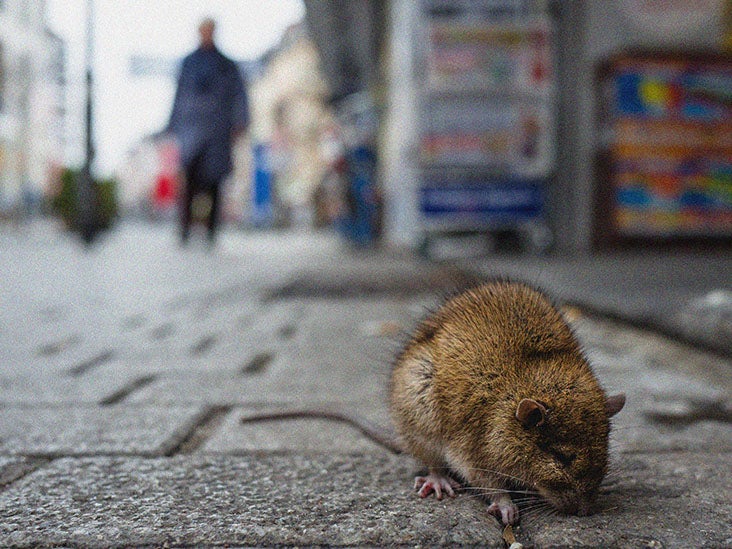Rat-bite fever: Symptoms and treatment - Medical News Today

Rat-bite fever is a bacterial infection that transmits through contact with rats, other rodents, and contaminated foods and drinks.
In May 2020, the
The risk of infection due to a rat bite is
Without antibiotic treatment, RBF can cause severe complications, including damage to bones and inflammation of the heart, brain, and spinal cord. It can be fatal.
In this article, we describe RBF and discuss its causes and treatments.
RBF is a severe infection caused by Streptobacillus moniliformis or Spirillum minus bacteria. These spread to humans through rat bites, contact with rat urine and feces, and contaminated foods and drinks.
As researchers observe in a
They go on to report that RBF tends to develop in children younger than 5 years who are living in conditions of poverty.
The researchers also note that people working with rats in pet stores and labs are at risk, and that the risk of an infection stemming from a bite is roughly 10%.
In a
RBF can cause severe complications, and an estimated
There are two types of RBF. The most common type in North America is called streptobacillary RBF, as it results from infection with S. moniliformis.
The other type is spirillary RBF, or sodoku. It is caused by S. minus bacteria, and this is the primary type in Asia.
A person develops RBF after one of these types of bacteria enters the body, through an open wound or the mucous membranes of the eyes, nose, or mouth.
The bacteria that cause RBF
- bites or scratches from infected rodents
- the saliva, urine, or feces of infected rodents
- contact with contaminated surfaces
- contaminated foods or drinks
Although reports of RBF occur globally, this disease is relatively rare. However, a person may have a higher risk of RBF if they:
- handle rats as part of their work
- live in an infested building or area
- keep rats or other rodents as pets
RBF does not pass from person to person.
The symptoms of RBF vary depending on the underlying bacterial infection.
S. moniliformis has an incubation period of
Symptoms of streptobacillary RBF include:
- a fever that comes and goes for several weeks
- a rash near a rat bite
- joint and muscle pain, especially in the lower back
- chills
- nausea
- vomiting
- a sore throat
A bite that causes spirillary RBF may start healing before the symptoms appear. The symptoms may take
- a fever and chills
- muscle and joint pain
- a headache
- a sore throat
- vomiting
- inflammation and ulceration near the site of the bite
- a brown or purple rash
- hard or tender lymph nodes
Doctors treat RBF with antibiotics. A person takes them for 7–14 days or up to
If a person does not receive treatment, RBF can lead to
- abscesses, or pockets of fluid inside the body
- inflammation of the liver or kidneys
- interstitial pneumonia, which causes lung scarring
- infections of the membranes covering the brain and spinal cord
- endocarditis, or inflammation of the membrane surrounding the heart
- bone damage
If RBF causes endocarditis, the mortality rate is 53%.
Penicillin is the current antibiotic of choice for both types of RBF.
However, penicillin can trigger allergic responses in some people. According to the
Signs of a penicillin allergy include:
- hives, which are itchy, raised bumps on the skin
- swelling of the face, hands, and feet
- difficulty breathing
- coughing
- chest tightness
- dizziness
People with penicillin allergies
Without treatment, RBF can cause severe, even life-threatening complications. Seek immediate medical attention if any unusual symptoms follow a rat bite.
A doctor can diagnose S. moniliformis by taking a sample of blood or tissue for testing. A person usually receives the results within 3 days, though the timing can vary.
To diagnose S. minus, a doctor takes a tissue sample for testing. The tissue is placed on a glass slide and treated with a stain. A laboratory technician examines this slide and can recognize the bacteria by their size, shape, and color.
RBF is a severe infection caused by the S. moniliformis and S. minus bacteria. These bacteria transmit to humans through rat bites and contaminated food or drinks.
RBF usually leads to nonspecific symptoms, such as fever, joint pain, and nausea. If left untreated, RBF can lead to severe complications, such as endocarditis or inflammation of the membrane surrounding the heart.
Doctors treat RBF with antibiotics. It is important that people complete the entire course of antibiotics, even if they no longer feel sick. Doing so can help prevent recurring infections and antibiotic resistance.



Comments
Post a Comment